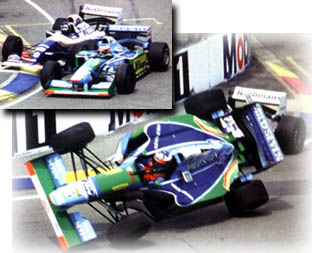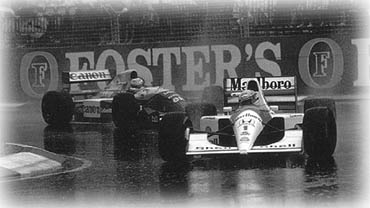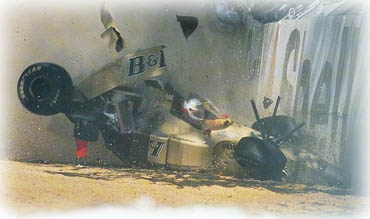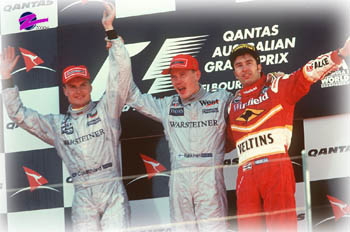 |
|
| The Nostalgia Column | |
| Looking back at the history of the Australian GP | by Marcel Schot, The Netherlands |
|
The Australian Grand Prix has always been a special race, be it at the start of the season or at the very end. The first Australian Grand Prix and the ten that followed, took place on the streets of Adelaide. Being a track with sections of tight corners and fast straights, it always demanded the maximum of the drivers' ability to put together a good setup.
Two years later, Ayrton Senna and Alain Prost came to Australia with just three points separating them. Both McLaren drivers were miles ahead of the rest. During the season Prost had accumulated the most points, yet Senna lead the championship because only the best eleven out of sixteen results counted. Although a gap of three points seems far from impossible to overcome, the regulations left the Frenchman in need of a miracle to catch the title. Prost had accomplished six wins and seven second places until Adelaide, while Senna had scored eight wins, two second places, a fourth and a sixth place. With this in mind, the Brazilian had to improve his fourth place in order to gain points from the final race. However, his arch-rival needed to win to improve his points total. This left the Frenchman with only little hope, since the best he could get was equal to Senna and to accomplish that he needed a win, while the Brazilian had to finish fourth or lower. The first happened, but Senna just followed his rival, finishing second and taking the title easily.
However, when the two titans had left the race, it gave way to an exciting battle between Nigel Mansell and Gerhard Berger (Ferrari), with first Mansell taking the lead, then Berger and finally Mansell again after a slight mistake by the Austrian. Incidentally, it was Mansell's final Formula One victory. But not only the championship decisions caused controversy in Adelaide. The rain played its dramatic part too down under. In 1989 rain hit the track for the first time on race day and caused the race to be stopped after two laps. World Champion Alain Prost then refused to take part in the restart, proving himself right when many drivers spun off or collided. Only eight drivers reached the finish line after two hours, with Williams driver Thierry Boutsen taking a surprise win and Lotus' Satoru Nakajima being the biggest surprise of all, taking the fastest lap honours.
In 1995 the entire Formula One community held its breath during qualifying, when Mika Hakkinen lost control of his McLaren when a tyre blew, coming onto the straight at above 200 kmh. The car skid into the wall backwards and the Finn hit his head onto the steering wheel, knocking him unconscious. Hakkinen was held in a coma in order to prevent brain damage, but the day after the accident he woke up and the injuries appeared to be less serious than first expected. In the shadow of Hakkinen's accident, Damon Hill won the final Adelaide Grand Prix. After eleven years of Adelaide action, the Australian Grand Prix found a new home. Just as controversial as many of the races, the race moved to Albert Park, a beautiful piece of nature in the heart of Melbourne. However, many protests by environmentalists could not keep away Bernie Ecclestone and his circus. Just like he had won the final race of 1995 in Adelaide, Damon Hill brought Williams victory in the first race of 1996 in Melbourne. However, his win did not come easy. Hill could only grab first place after his rookie teammate Jacques Villeneuve, having grabbed pole on his first Formula One race, was forced to slow down by engine problems and give up what could have been a historic maiden win. Nevertheless, the Williams one-two wasn't the most remarkable moment of the race. After the first corner David Coulthard's McLaren drifted wide and, together with Johnny Herbert's Sauber, act as launching pad for the Jordan of Martin Brundle. The Jordan broke in two, but after the dust faded the monocoque presented its power, as Brundle walked away a very lucky and unharmed man.
But the prize for the biggest stupidity of the year was taken right away by Jean Alesi. While not having radio contact with the team, the Frenchman also forgot to check his pitboard and neglected to come in for a much needed pit-stop. After 35 laps, his Benetton ran out of fuel leaving him stranded at the track-side, having just missed a good chance of a podium position.
By the way, there was a big misunderstanding at last year's Australian Grand Prix. Common knowledge has it that the 100,000 Australian fans which packed Albert Park were booing at the awards ceremony for McLaren's team tactics that 'fixed' the race. However, it was later discovered that the crowd was in fact booing for John Howard, the Australian Prime Minister, and not for McLaren. It appears that this incident had more to do with consumption of Foster's Lager by the more radical elements of the Australian crowd than appreciation of the finer points of Grand Prix racing. None the less, the city of Melbourne has worked hard to build its international image ever since, and were not happy that this incident was recorded on the F1 World feed. What happened last year:
|
| 1998 Race Results | ||||
| Mika Hakkinen | McLaren-Mercedes | 1h 31:45.996s | ||
| David Coulthard | McLaren-Mercedes | + 0.702s | ||
| H.H. Frentzen | Williams-Mecachrome | + 1 lap | ||
| Eddie Irvine | Ferrari | + 1 lap | ||
 5. 5. | Jacques Villeneuve | Williams-Mecachrome | + 1 lap | |
| Johnny Herbert | Sauber-Petronas | + 1 lap | ||
| Mika Hakkinen | McLaren-Mercedes | 1:30.010s | ||
| Mika Hakkinen | McLaren-Mercedes | 1:31.649s | ||
| Marcel Schot | © 1999 Atlas Formula One Journal. |
| Send comments to: schot@atlasf1.com | Terms & Conditions |
 Although being the final race of the season, the Australian Grand Prix only hosted three championship deciding races. The first of those was in 1986. Nigel Mansell entered the race with a comfortable lead of seven points over both Alain Prost (McLaren) and his Williams teammate Nelson Piquet. After qualifying things looked pretty much settled with Mansell taking pole, Piquet completing the Williams first row and Prost qualifying fourth, over a second behind the pole time. While Piquet took the lead at the start, Mansell comfortably raced lap after lap, taking care of the gap not growing too big. All of a sudden, after 63 laps, the camera switched back from Nelson Piquet, who had just regained the lead from McLaren driver Keke Rosberg, to Nigel Mansell. In an stream of fire sparks the Williams skid down the main straight, ending Mansell's race in tears. While Goodyear had just assured the team that the tyres were no problem at all, Mansell's rear tyre had blown up. In a controversial decision, leader Piquet was immediately called in for fresh rubber, thus handing Alain Prost the title.
Although being the final race of the season, the Australian Grand Prix only hosted three championship deciding races. The first of those was in 1986. Nigel Mansell entered the race with a comfortable lead of seven points over both Alain Prost (McLaren) and his Williams teammate Nelson Piquet. After qualifying things looked pretty much settled with Mansell taking pole, Piquet completing the Williams first row and Prost qualifying fourth, over a second behind the pole time. While Piquet took the lead at the start, Mansell comfortably raced lap after lap, taking care of the gap not growing too big. All of a sudden, after 63 laps, the camera switched back from Nelson Piquet, who had just regained the lead from McLaren driver Keke Rosberg, to Nigel Mansell. In an stream of fire sparks the Williams skid down the main straight, ending Mansell's race in tears. While Goodyear had just assured the team that the tyres were no problem at all, Mansell's rear tyre had blown up. In a controversial decision, leader Piquet was immediately called in for fresh rubber, thus handing Alain Prost the title.
 Another six years later brought Adelaide its third and final championship decision and by far the most controversial of recent years. Entering the race with a one point lead over Williams' Damon Hill, after an already controversial season, Michael Schumacher qualified his Benetton second in between one-time returnee Nigel Mansell and his teammate Damon Hill. Not happy being squeezed between the two Williams', Schumacher immediately grabbed the lead with no intention of letting anyone pass him. After having made a steering mistake on lap 36, Damon Hill closed the gap to the German and the two collided. While Schumacher was directly out of the race, Damon Hill continued and reached the pits. After a long check of the Williams' suspension, it became clear that Hill wasn't able to continue and that Schumacher had won his first title. To this day, the incident of Adelaide '94 seems to haunt both Schumacher and Hill, not to mention their respective fans.
Another six years later brought Adelaide its third and final championship decision and by far the most controversial of recent years. Entering the race with a one point lead over Williams' Damon Hill, after an already controversial season, Michael Schumacher qualified his Benetton second in between one-time returnee Nigel Mansell and his teammate Damon Hill. Not happy being squeezed between the two Williams', Schumacher immediately grabbed the lead with no intention of letting anyone pass him. After having made a steering mistake on lap 36, Damon Hill closed the gap to the German and the two collided. While Schumacher was directly out of the race, Damon Hill continued and reached the pits. After a long check of the Williams' suspension, it became clear that Hill wasn't able to continue and that Schumacher had won his first title. To this day, the incident of Adelaide '94 seems to haunt both Schumacher and Hill, not to mention their respective fans.
 In 1991 the rain returned in even more spectacular fashion. After fourteen laps, the race was stopped, making it the shortest race ever. Ayrton Senna had proven himself the rainmaster to that point, leading his McLaren to victory in front of Mansell's Williams and teammate Gerhard Berger.
In 1991 the rain returned in even more spectacular fashion. After fourteen laps, the race was stopped, making it the shortest race ever. Ayrton Senna had proven himself the rainmaster to that point, leading his McLaren to victory in front of Mansell's Williams and teammate Gerhard Berger.
 The next year Villeneuve appeared to be set to get his Australian win after all, qualifying 1.7 second in front of teammate Heinz-Harald Frentzen and over 2 second ahead of the rest. However, after one corner Ferrari driver Eddie Irvine ended Villeneuve's illusion when crashing into him. After 58 laps, David Coulthard collected McLaren's first win after Adelaide 1993. Nonetheless, the most attention went to the back of the grid. Some attention went to the terrible Lola's who qualified over ten seconds behind the pole in their first and only attempt at a Formula One comeback. However, most attention went to World Champion Damon Hill, who, after having been dumped by Williams, tried his luck at Arrows. With only seconds to go, he managed to keep from the disgrace of not qualifying for the race. In his final attempt, the Briton managed a 20th position, only beating Tyrrell's Jos Verstappen, teammate Pedro Diniz and both Lola's. As if the drama wasn't complete, Damon's car failed during the parade lap, giving the World Champion a not so happy preview of what would come.
The next year Villeneuve appeared to be set to get his Australian win after all, qualifying 1.7 second in front of teammate Heinz-Harald Frentzen and over 2 second ahead of the rest. However, after one corner Ferrari driver Eddie Irvine ended Villeneuve's illusion when crashing into him. After 58 laps, David Coulthard collected McLaren's first win after Adelaide 1993. Nonetheless, the most attention went to the back of the grid. Some attention went to the terrible Lola's who qualified over ten seconds behind the pole in their first and only attempt at a Formula One comeback. However, most attention went to World Champion Damon Hill, who, after having been dumped by Williams, tried his luck at Arrows. With only seconds to go, he managed to keep from the disgrace of not qualifying for the race. In his final attempt, the Briton managed a 20th position, only beating Tyrrell's Jos Verstappen, teammate Pedro Diniz and both Lola's. As if the drama wasn't complete, Damon's car failed during the parade lap, giving the World Champion a not so happy preview of what would come.
 Last year gave Melbourne its first on-track controversy. After having completely dominated the weekend, both McLarens rocketed away from the field, lapping every other car. After having lead for most of the race Mika Hakkinen went in for his pitstop, only to find no crew waiting for him. The second time around the crew was ready, but the flying Finn lost the lead to his teammate David Coulthard. However, when the ending of the race came close, the Scotsman suddenly lost speed, leaving Mika Hakkinen a chance to pass him and take the win. Later it was discovered that both drivers had agreed that whoever entered the first corner first, would win the race. The team-tactics yielded much protests by the other teams and left the FIA changing their regulations in order to prevent similar situations in the future.
Last year gave Melbourne its first on-track controversy. After having completely dominated the weekend, both McLarens rocketed away from the field, lapping every other car. After having lead for most of the race Mika Hakkinen went in for his pitstop, only to find no crew waiting for him. The second time around the crew was ready, but the flying Finn lost the lead to his teammate David Coulthard. However, when the ending of the race came close, the Scotsman suddenly lost speed, leaving Mika Hakkinen a chance to pass him and take the win. Later it was discovered that both drivers had agreed that whoever entered the first corner first, would win the race. The team-tactics yielded much protests by the other teams and left the FIA changing their regulations in order to prevent similar situations in the future.